Sarkar Snigdha Sarathi Das
Training Step-Level Reasoning Verifiers with Formal Verification Tools
May 21, 2025Abstract:Process Reward Models (PRMs), which provide step-by-step feedback on the reasoning generated by Large Language Models (LLMs), are receiving increasing attention. However, two key research gaps remain: collecting accurate step-level error labels for training typically requires costly human annotation, and existing PRMs are limited to math reasoning problems. In response to these gaps, this paper aims to address the challenges of automatic dataset creation and the generalization of PRMs to diverse reasoning tasks. To achieve this goal, we propose FoVer, an approach for training PRMs on step-level error labels automatically annotated by formal verification tools, such as Z3 for formal logic and Isabelle for theorem proof, which provide automatic and accurate verification for symbolic tasks. Using this approach, we synthesize a training dataset with error labels on LLM responses for formal logic and theorem proof tasks without human annotation. Although this data synthesis is feasible only for tasks compatible with formal verification, we observe that LLM-based PRMs trained on our dataset exhibit cross-task generalization, improving verification across diverse reasoning tasks. Specifically, PRMs trained with FoVer significantly outperform baseline PRMs based on the original LLMs and achieve competitive or superior results compared to state-of-the-art PRMs trained on labels annotated by humans or stronger models, as measured by step-level verification on ProcessBench and Best-of-K performance across 12 reasoning benchmarks, including MATH, AIME, ANLI, MMLU, and BBH. The datasets, models, and code are provided at https://github.com/psunlpgroup/FoVer.
HRScene: How Far Are VLMs from Effective High-Resolution Image Understanding?
Apr 29, 2025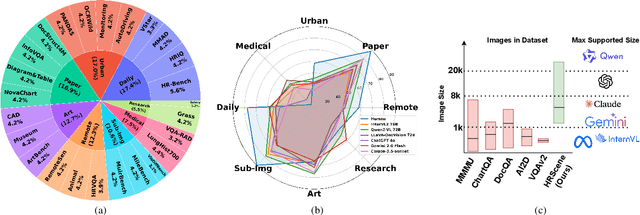
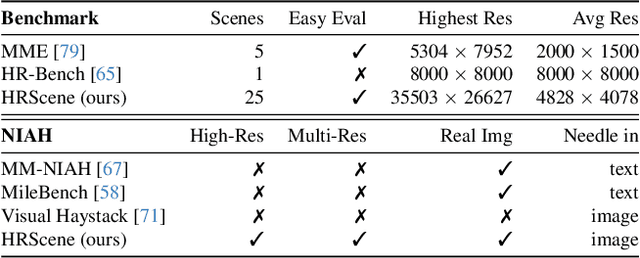
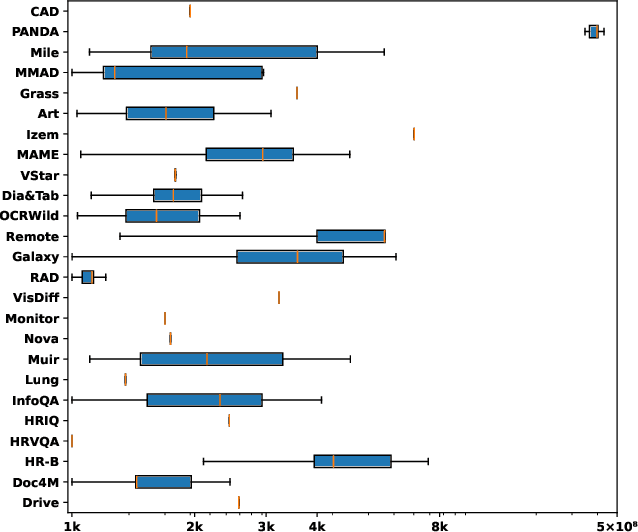

Abstract:High-resolution image (HRI) understanding aims to process images with a large number of pixels, such as pathological images and agricultural aerial images, both of which can exceed 1 million pixels. Vision Large Language Models (VLMs) can allegedly handle HRIs, however, there is a lack of a comprehensive benchmark for VLMs to evaluate HRI understanding. To address this gap, we introduce HRScene, a novel unified benchmark for HRI understanding with rich scenes. HRScene incorporates 25 real-world datasets and 2 synthetic diagnostic datasets with resolutions ranging from 1,024 $\times$ 1,024 to 35,503 $\times$ 26,627. HRScene is collected and re-annotated by 10 graduate-level annotators, covering 25 scenarios, ranging from microscopic to radiology images, street views, long-range pictures, and telescope images. It includes HRIs of real-world objects, scanned documents, and composite multi-image. The two diagnostic evaluation datasets are synthesized by combining the target image with the gold answer and distracting images in different orders, assessing how well models utilize regions in HRI. We conduct extensive experiments involving 28 VLMs, including Gemini 2.0 Flash and GPT-4o. Experiments on HRScene show that current VLMs achieve an average accuracy of around 50% on real-world tasks, revealing significant gaps in HRI understanding. Results on synthetic datasets reveal that VLMs struggle to effectively utilize HRI regions, showing significant Regional Divergence and lost-in-middle, shedding light on future research.
GREATERPROMPT: A Unified, Customizable, and High-Performing Open-Source Toolkit for Prompt Optimization
Apr 04, 2025

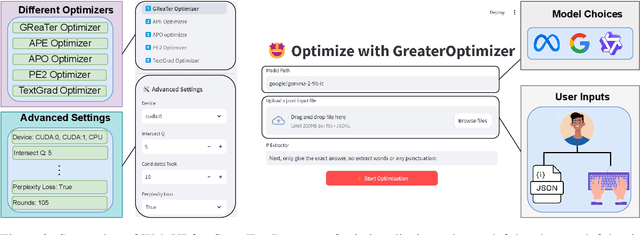

Abstract:LLMs have gained immense popularity among researchers and the general public for its impressive capabilities on a variety of tasks. Notably, the efficacy of LLMs remains significantly dependent on the quality and structure of the input prompts, making prompt design a critical factor for their performance. Recent advancements in automated prompt optimization have introduced diverse techniques that automatically enhance prompts to better align model outputs with user expectations. However, these methods often suffer from the lack of standardization and compatibility across different techniques, limited flexibility in customization, inconsistent performance across model scales, and they often exclusively rely on expensive proprietary LLM APIs. To fill in this gap, we introduce GREATERPROMPT, a novel framework that democratizes prompt optimization by unifying diverse methods under a unified, customizable API while delivering highly effective prompts for different tasks. Our framework flexibly accommodates various model scales by leveraging both text feedback-based optimization for larger LLMs and internal gradient-based optimization for smaller models to achieve powerful and precise prompt improvements. Moreover, we provide a user-friendly Web UI that ensures accessibility for non-expert users, enabling broader adoption and enhanced performance across various user groups and application scenarios. GREATERPROMPT is available at https://github.com/psunlpgroup/GreaterPrompt via GitHub, PyPI, and web user interfaces.
Can LLMs Rank the Harmfulness of Smaller LLMs? We are Not There Yet
Feb 07, 2025



Abstract:Large language models (LLMs) have become ubiquitous, thus it is important to understand their risks and limitations. Smaller LLMs can be deployed where compute resources are constrained, such as edge devices, but with different propensity to generate harmful output. Mitigation of LLM harm typically depends on annotating the harmfulness of LLM output, which is expensive to collect from humans. This work studies two questions: How do smaller LLMs rank regarding generation of harmful content? How well can larger LLMs annotate harmfulness? We prompt three small LLMs to elicit harmful content of various types, such as discriminatory language, offensive content, privacy invasion, or negative influence, and collect human rankings of their outputs. Then, we evaluate three state-of-the-art large LLMs on their ability to annotate the harmfulness of these responses. We find that the smaller models differ with respect to harmfulness. We also find that large LLMs show low to moderate agreement with humans. These findings underline the need for further work on harm mitigation in LLMs.
GReaTer: Gradients over Reasoning Makes Smaller Language Models Strong Prompt Optimizers
Dec 12, 2024


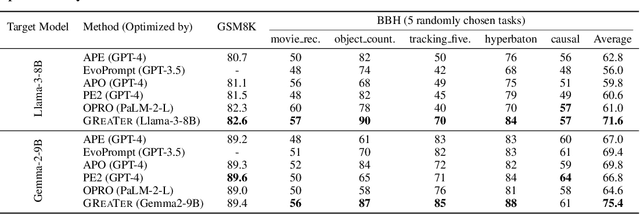
Abstract:The effectiveness of large language models (LLMs) is closely tied to the design of prompts, making prompt optimization essential for enhancing their performance across a wide range of tasks. Many existing approaches to automating prompt engineering rely exclusively on textual feedback, refining prompts based solely on inference errors identified by large, computationally expensive LLMs. Unfortunately, smaller models struggle to generate high-quality feedback, resulting in complete dependence on large LLM judgment. Moreover, these methods fail to leverage more direct and finer-grained information, such as gradients, due to operating purely in text space. To this end, we introduce GReaTer, a novel prompt optimization technique that directly incorporates gradient information over task-specific reasoning. By utilizing task loss gradients, GReaTer enables self-optimization of prompts for open-source, lightweight language models without the need for costly closed-source LLMs. This allows high-performance prompt optimization without dependence on massive LLMs, closing the gap between smaller models and the sophisticated reasoning often needed for prompt refinement. Extensive evaluations across diverse reasoning tasks including BBH, GSM8k, and FOLIO demonstrate that GReaTer consistently outperforms previous state-of-the-art prompt optimization methods, even those reliant on powerful LLMs. Additionally, GReaTer-optimized prompts frequently exhibit better transferability and, in some cases, boost task performance to levels comparable to or surpassing those achieved by larger language models, highlighting the effectiveness of prompt optimization guided by gradients over reasoning. Code of GReaTer is available at https://github.com/psunlpgroup/GreaTer.
VisOnlyQA: Large Vision Language Models Still Struggle with Visual Perception of Geometric Information
Dec 01, 2024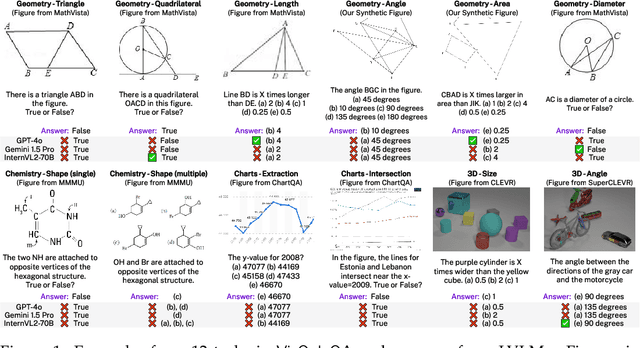

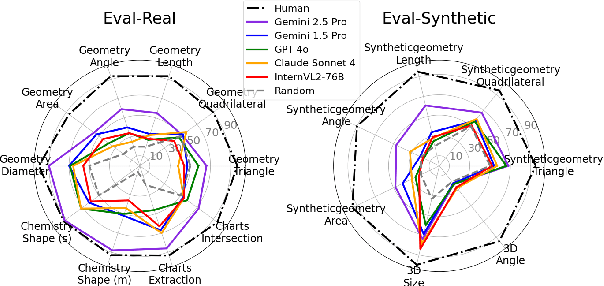

Abstract:Errors in understanding visual information in images (i.e., visual perception errors) remain a major source of mistakes in Large Vision Language Models (LVLMs). While further analysis is essential, there is a deficiency in datasets for evaluating the visual perception of LVLMs. In this work, we introduce VisOnlyQA, a new dataset designed to directly evaluate the visual perception capabilities of LVLMs on questions about geometric and numerical information in scientific figures. Our dataset enables us to analyze the visual perception of LVLMs for fine-grained visual information, independent of other capabilities such as reasoning. The evaluation set of VisOnlyQA includes 1,200 multiple-choice questions in 12 tasks on four categories of figures. We also provide synthetic training data consisting of 70k instances. Our experiments on VisOnlyQA highlight the following findings: (i) 20 LVLMs we evaluate, including GPT-4o and Gemini 1.5 Pro, work poorly on the visual perception tasks in VisOnlyQA, while human performance is nearly perfect. (ii) Fine-tuning on synthetic training data demonstrates the potential for enhancing the visual perception of LVLMs, but observed improvements are limited to certain tasks and specific models. (iii) Stronger language models improve the visual perception of LVLMs. In summary, our experiments suggest that both training data and model architectures should be improved to enhance the visual perception capabilities of LVLMs. The datasets, code, and model responses are provided at https://github.com/psunlpgroup/VisOnlyQA.
Verbosity $ eq$ Veracity: Demystify Verbosity Compensation Behavior of Large Language Models
Nov 12, 2024



Abstract:When unsure about an answer, humans often respond with more words than necessary, hoping that part of the response will be correct. We observe a similar behavior in large language models (LLMs), which we term "Verbosity Compensation" (VC). VC is harmful because it confuses the user understanding, leading to low efficiency, and influences the LLM services by increasing the latency and cost of generating useless tokens. In this paper, we present the first work that defines and analyzes Verbosity Compensation, explores its causes, and proposes a simple mitigating approach. We define Verbosity Compensation as the behavior of generating responses that can be compressed without information loss when prompted to write concisely. Our experiments, conducted on five datasets of knowledge and reasoning-based QA tasks with 14 newly developed LLMs, reveal three conclusions. 1) We reveal a pervasive presence of verbosity compensation across all models and all datasets. Notably, GPT-4 exhibits a VC frequency of 50.40%. 2) We reveal the large performance gap between verbose and concise responses, with a notable difference of 27.61% on the Qasper dataset. We also demonstrate that this difference does not naturally diminish as LLM capability increases. Both 1) and 2) highlight the urgent need to mitigate the frequency of VC behavior and disentangle verbosity with veracity. We propose a simple yet effective cascade algorithm that replaces the verbose responses with the other model-generated responses. The results show that our approach effectively alleviates the VC of the Mistral model from 63.81% to 16.16% on the Qasper dataset. 3) We also find that verbose responses exhibit higher uncertainty across all five datasets, suggesting a strong connection between verbosity and model uncertainty. Our dataset and code are available at https://github.com/psunlpgroup/VerbosityLLM.
Evaluating LLMs at Detecting Errors in LLM Responses
Apr 04, 2024



Abstract:With Large Language Models (LLMs) being widely used across various tasks, detecting errors in their responses is increasingly crucial. However, little research has been conducted on error detection of LLM responses. Collecting error annotations on LLM responses is challenging due to the subjective nature of many NLP tasks, and thus previous research focuses on tasks of little practical value (e.g., word sorting) or limited error types (e.g., faithfulness in summarization). This work introduces ReaLMistake, the first error detection benchmark consisting of objective, realistic, and diverse errors made by LLMs. ReaLMistake contains three challenging and meaningful tasks that introduce objectively assessable errors in four categories (reasoning correctness, instruction-following, context-faithfulness, and parameterized knowledge), eliciting naturally observed and diverse errors in responses of GPT-4 and Llama 2 70B annotated by experts. We use ReaLMistake to evaluate error detectors based on 12 LLMs. Our findings show: 1) Top LLMs like GPT-4 and Claude 3 detect errors made by LLMs at very low recall, and all LLM-based error detectors perform much worse than humans. 2) Explanations by LLM-based error detectors lack reliability. 3) LLMs-based error detection is sensitive to small changes in prompts but remains challenging to improve. 4) Popular approaches to improving LLMs, including self-consistency and majority vote, do not improve the error detection performance. Our benchmark and code are provided at https://github.com/psunlpgroup/ReaLMistake.
Unified Low-Resource Sequence Labeling by Sample-Aware Dynamic Sparse Finetuning
Nov 07, 2023



Abstract:Unified Sequence Labeling that articulates different sequence labeling problems such as Named Entity Recognition, Relation Extraction, Semantic Role Labeling, etc. in a generalized sequence-to-sequence format opens up the opportunity to make the maximum utilization of large language model knowledge toward structured prediction. Unfortunately, this requires formatting them into specialized augmented format unknown to the base pretrained language model (PLMs) necessitating finetuning to the target format. This significantly bounds its usefulness in data-limited settings where finetuning large models cannot properly generalize to the target format. To address this challenge and leverage PLM knowledge effectively, we propose FISH-DIP, a sample-aware dynamic sparse finetuning strategy that selectively focuses on a fraction of parameters, informed by feedback from highly regressing examples, during the fine-tuning process. By leveraging the dynamism of sparsity, our approach mitigates the impact of well-learned samples and prioritizes underperforming instances for improvement in generalization. Across five tasks of sequence labeling, we demonstrate that FISH-DIP can smoothly optimize the model in low resource settings offering upto 40% performance improvements over full fine-tuning depending on target evaluation settings. Also, compared to in-context learning and other parameter-efficient fine-tuning approaches, FISH-DIP performs comparably or better, notably in extreme low-resource settings.
Hermes: Unlocking Security Analysis of Cellular Network Protocols by Synthesizing Finite State Machines from Natural Language Specifications
Oct 11, 2023
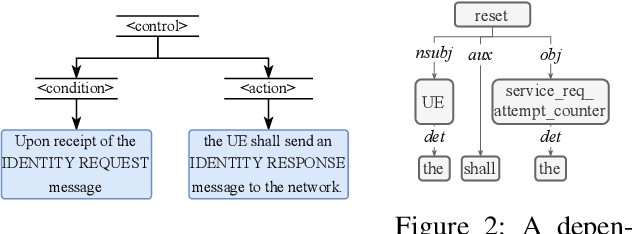


Abstract:In this paper, we present Hermes, an end-to-end framework to automatically generate formal representations from natural language cellular specifications. We first develop a neural constituency parser, NEUTREX, to process transition-relevant texts and extract transition components (i.e., states, conditions, and actions). We also design a domain-specific language to translate these transition components to logical formulas by leveraging dependency parse trees. Finally, we compile these logical formulas to generate transitions and create the formal model as finite state machines. To demonstrate the effectiveness of Hermes, we evaluate it on 4G NAS, 5G NAS, and 5G RRC specifications and obtain an overall accuracy of 81-87%, which is a substantial improvement over the state-of-the-art. Our security analysis of the extracted models uncovers 3 new vulnerabilities and identifies 19 previous attacks in 4G and 5G specifications, and 7 deviations in commercial 4G basebands.
 Add to Chrome
Add to Chrome Add to Firefox
Add to Firefox Add to Edge
Add to Edge